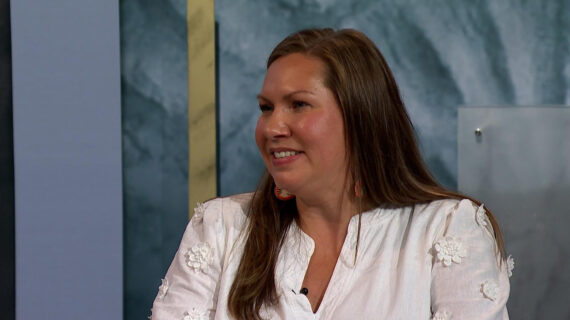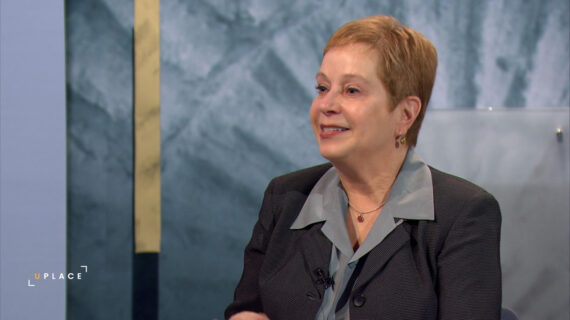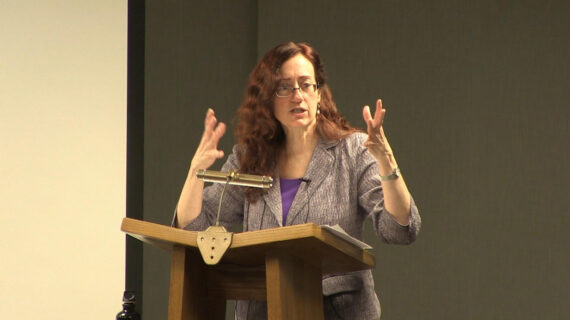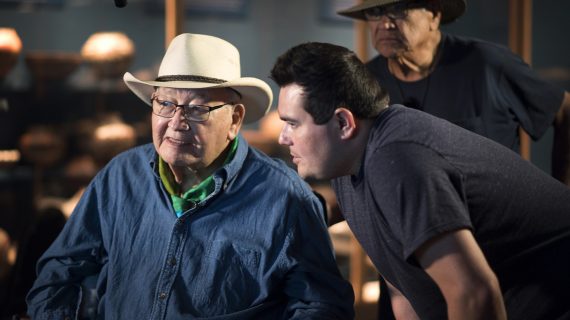[Norman Gilliland, Host, University Place Presents]
Welcome to University Place Presents. I’m Norman Gilliland, and we’re going to call this hour “Carols of Christmas Past” because it’s going to be something of a restoration of these familiar tunes to their state as they were, if not originally in all cases, at least long ago. And so, some of the titles may not match the tunes that you’re going to be hearing today because that’s, in fact, what these things originally sounded like if you go back to the 19th century, or even before. We have just right instrument for that. We’ll tell you a little bit about that later. And we have just the right person to guide us through some of these tunes, and that’s Trevor Stephenson. Welcome back to University Place Presents.
[Trevor Stephenson, Director, Madison Bach Musicians]
Thank you. It’s my pleasure.
Good and I – I think, as you said, we are – it is a restoration, and if – if we’re doing any sense of a time machine in this, this would probably be the Victorian drawing room and the way that music was made through – through the 19th century, into the early 20th century mostly, until the radio really began to push this out.
People made their own music, and the upright piano was – was – was the cohesion, you know, for this. It held it together.
[Norman Gilliland]
The instrument of choice.
[Trevor Stephenson]
Yeah. People – people gathered around and, again, we’ll talk about this – this beautiful 1840s instrument when we get there.
[Norman Gilliland]
So, before we hear the first set, the first three pieces, let’s get a little bit of background on them. Starting with one that was, of course, a big, big, big, big –
[Trevor Stephenson]
Right.
[Norman Gilliland]
– hit for Bing Crosby –
[Trevor Stephenson]
Right.
[Norman Gilliland]
– but that isn’t the way it sounded originally.
[Trevor Stephenson]
Well, you know, in planning this program, I thought, “Well, there’s – theres only one way to avoid having “Silent Night” at the end of a concert, and that’s to have it at the beginning.
[laughter]
So – and – and because you can’t put it in the middle. It really doesn’t go anyway. And there’s a good reason for it. But we’re gonna – were gonna be doing the original Silent Night, the Stille Nacht, written by Franz Gruber in 1818 in a little village in Austria. And of all things, many, many years ago, never mind how many, as – as Melville would have said, I was visiting a friend in Austria, and – and we were looking at his pianos, and we took a break, out the back door. He said, Here’s our village, and he opened the door and there’s a little church. And on the corner of this church, it said Franz Gruber wrote “Silent Night” here in 1818 in this tiny Dorf in Austria.
[Norman Gilliland]
And –
[Trevor Stephenson]
And so, I love that everything comes from somewhere. And –
[Norman Gilliland]
Well, that’s true. And point well taken because even in Gruber’s own time, this piece, this song, was so popular that a lot of people thought it was a folk song.
[Trevor Stephenson]
Right. Yeah.
[Norman Gilliland]
He said, No, I wrote it in 1818, and it was for a specific purpose. The legend is kind of true about the mice chewing through the bellows –
[Trevor Stephenson]
Oh, yeah.
[Norman Gilliland]
– of the organ. And so, they needed on short order something that – that required –
[Trevor Stephenson]
Oh, thats right.
[Norman Gilliland]
– the organ?
[Trevor Stephenson]
They played it on –
[Norman Gilliland]
So, it was actually a guitar.
[Trevor Stephenson]
A guitar, right.
[Norman Gilliland]
And a – and a singer or two.
[Trevor Stephenson]
Right.
[Norman Gilliland]
But more up tempo than –
[Trevor Stephenson]
And –
[Norman Gilliland]
– what we’re used to.
[Trevor Stephenson]
Right.
[Norman Gilliland]
And it’s got this wonderful kind of Austrian Tyrolian lilt to it.
[Trevor Stephenson]
It does. Right. You can even hear the way that the voices are – are – are – are coupled with the type of writing. There’s even a little bit of a sense of yodeling.
[Norman Gilliland]
Yeah!
[Trevor Stephenson]
Right.
[Norman Gilliland]
Exactly.
[Trevor Stephenson]
And I know, which is a long way from the Silent Night, as – as it has become fossilized for us.
[Norman Gilliland]
Crosby did so little yodeling.
[Trevor Stephenson]
Yeah, right. [laughs] Anyway, it’s – its very charming. And then we’re going to follow that with the old Bring a Torch, Jeanette Isabella.
[Norman Gilliland]
French originally.
[Trevor Stephenson]
We’re gonna do – were gonna mix it up, right. We’re gonna have one verse in English, and then two verses in French, right? And its a – and it ends very quietly. As – as you’re – youre, you know, coming to the place where Jesus is born, and please be quiet because don’t wake him up. That’s – thats the gist of the song. You know?
[Norman Gilliland]
And then another one where we’re used to a certain tune –
[Trevor Stephenson]
Right.
[Norman Gilliland]
– from “The Holly and the Ivy,” but this isn’t that tune.
[Trevor Stephenson]
Right. This is the old French tune for The Holly and the Ivy. It has nothing to do with the – the tune that usually appears when you hear The Holly and the Ivy is on the program. It’s much darker. It’s in a minor key. It has fantastic Renaissance chord progressions in it and almost an organ-like style at – at the piano and also the way voices create this really tight Renaissance harmony.
So, it’s – its one of my favorites. Mozart actually wrote a set of variations for violin and – and piano on this very tune as well. So, we’ll do those three as a starter.
[Norman Gilliland]
And time now to introduce our singers then.
[Trevor Stephenson]
Yes, I was so thrilled to work with this vocal quartet on this – on this particular program. And so, if they’ll come on, we’ll introduce them. This is Margaret Fox, alto, right? Scott Brunscheen, tenor. Jim LaBelle is bass. And Alisa Jordheim will be singing soprano. Again, this is – this is the way it was done before email.
[laughter]
You know? People gathered around and – and had a great time.
[piano plays Stille Nacht and the choir sings]
* Stille Nacht! * Heilige Nacht! * einsam wacht * Nur das traute * hoch heilige Paar. * Holder Knab im lockigen Haar, * Schlafe in himmlischer * Ruh! * Schlafe in himmlischer * Ruh!
* Silent Night! * Holy Night! * All is calm, all is bright. * Round yon Virgin Mother and Child * Holy infant, so tender and mild, * Sleep in heavenly peace. * Sleep in heavenly peace.
* Stille Nacht! * Heilige Nacht! * Hirten erst * Kundgemacht * Durch der Engel * Alleluja, * Ferne und Nah * Jesus der Retter ist da! * Jesus der Retter ist da! * Jesus der Retter ist da! * Jesus der Retter ist da! *
[Piano plays Bring a torch, Jeanette Isabella and the choir sings]
* Bring a torch, Jeanette Isabella, * Bring a torch, * it is dark in the stall; * Jesus awaits, * good folks of the village, * Run quickly; * I hear Mary’s soft call.
* Ah! * Ah! * How radiant the Mother; * Ah! * Ah! * How angelic the Child.
* Un flambeau, Jeanette, Isabelle, * Un flambeau! * Courons au berceau! * Marie appelle! * Ah! * Ah! * Ah! * Ah! * Ah! Que l’Enfant est beau!
* Doucement, venez un moment! * Approchez! * Comme il est blanc! * Comme il est rose! * Do! * Do! * Do! Que l’Enfant repose! * Do! * Do! * Do! Qu’il rit en dormant!
[piano plays The Holly and the Ivy and the choir sings]
* The holly and the ivy, * Now both are full well grown, * Of all the trees that are in the wood, * The holly bears the crown. * O the rising of the sun, * The running of the deer, * The playing of the merry organ, * Sweet singing in the choir, * Sweet singing in the choir.
* The holly bears a blossom * As white as the lily flow’r: * And Mary bore sweet Jesus Christ * To be our sweet Savior. * O the rising of the sun, * The running of the deer, * The playing of the merry organ, * Sweet singing in the choir, * Sweet singing in the choir.
* The holly bears a berry, * As red as any blood; * And Mary bore sweet Jesus Christ, * To do us sinners good. * O the rising of the sun, * The running of the deer, * The playing of the merry organ, * Sweet singing in the choir, * Sweet singing in the choir.
[applause]
[Norman Gilliland]
Well, they do sound different, don’t they?
[Trevor Stephenson]
Yeah.
[Norman Gilliland]
And I have to say refreshingly so.
[Trevor Stephenson]
Yeah.
[Norman Gilliland]
As much as we like and are accustomed to the others, this gives a whole new slant on some of these –
[Trevor Stephenson]
Yeah.
[Norman Gilliland]
– Carols of Christmas Past.
[Trevor Stephenson]
Right, I always think Silent Night can be quiet, but not slow, right?
[Norman Gilliland]
There you go. Yeah, yeah, yeah. Fast, but silent. And you haven’t introduced Fred yet.
[Trevor Stephenson]
Fred. I know. And this piano we do – we call Fred for Frederic Chopin because Frederic Chopin had one of these in his studio. It was one of his favorite instruments. In fact, he usually played on an instrument like this throughout his lessons. He let the student at the grand, and he played all of his examples. And he loved this particular type of – of English sound in pianos. And we also know that Chopin had, in the studio, a piano like this that had this particular type of hammer, which is hollow. That is, the hammers that hit the strings here have no center whatsoever. It’s just a wooden ring covered with a few pieces of leather.
And so, it gives it that – that other-worldly sound because there’s – theres no crunch when the hammer hits the string. It’s just a kiss. And so – and, you know, of course, you can hear that the – the treble is very gossamer, up here like that. And the bass is really, it’s soft but quite low sounding. There’s a – a great difference in timbre from top to bottom in the instrument. Much like the human voice, you know, going from the soprano to the bass register. So, the instruments of the 19th century tend to emulate those vocal qualities, and you can hear all the other instruments in between, the other singers in between.
Also in this instrument, which is nice with this wonderful light here, you – you can see that this is a carved front. It’s not a solid front, like many later uprights would be. As uprights got bigger and louder and all that, they started putting just a solid piece of wood in the front to kind of block you from that tidal wave of sound that was really coming out of there. But in this more delicately voiced instrument, they were very careful to make sure that those strings, like harp-like strings, were accessible to the player. You could get all the – the genies and the fairies in the sound. And so, this is an open front. It’s just a carving. And then that is a cloth batten right there. That is, it’s just two thin layers of cloth with some silk curlings stuffed between it like that. And then the sound comes floating through.
And also, you know, this – this carved – this carved thing here is one piece. It’s not stamped. It’s carved. And some master and apprentice probably spent some very long, long hours. We always say this is pre-email.
[laughter]
[Norman Gilliland]
Very much.
[Trevor Stephenson]
You can’t even – if you even have email, you’ll never get something like this done. You know? So, anyway – and this instrument has also – it has no metal plate in it. It’s all wood. And that’s part of the – the reason that it has that – that incredible warmth of sound.
[Norman Gilliland]
Easier to carry too.
[Trevor Stephenson]
What’s that?
[Norman Gilliland]
Easier to carry.
[Norman Gilliland]
It is much easier to carry, as we found out yesterday. Yes. And so, but its – but thats – its all – its responsiveness is an entirely wooden structure. Because the strings are lower tension, you don’t have to have a massive metal plate in here. So, this is very typical of the English design in the mid-19th century. This instrument is probably about 1840, something like that. It is an original. It’s not one that we have, you know, built from scratch, but one that I have rebuilt twice. And I did all the stringing and the hammer work and even I made the bass strings over the course of a summer. So, anyway, we love Fred. [laughs]
[Norman Gilliland]
Well, you mentioned a fairy a little while ago. We’ll get to a fairy and – and
[Trevor Stephenson]
Right.
[Norman Gilliland]
– an Arabian too, I think.
[Trevor Stephenson]
Right. We’ll do them in – in reverse order. We’ll start with the hot sands, right? And then move to the colder north.
[Norman Gilliland]
Yeah. So then, as far as the – the fairy is concerned, the story has Tchaikovsky having just about finished The Nutcracker.
[Trevor Stephenson]
Um-hmm.
[Norman Gilliland]
He was trying to think of an instrument that would apply to the Sugar Plum Fairy –
[Trevor Stephenson]
Right.
[Norman Gilliland]
– and he was just flummoxed. Could not come up with one –
[Trevor Stephenson]
Right.
[Norman Gilliland]
– and the somewhere in his travels he heard a celesta.
[Trevor Stephenson]
Right. I think –
[Norman Gilliland]
And said, That’s it!
[Trevor Stephenson]
Right.
[Norman Gilliland]
That’s it! And while this piano obviously is not a celesta, it has many of those wonderful, as you say –
[Trevor Stephenson]
Right.
[Norman Gilliland]
– fairy-like qualities.
[Trevor Stephenson]
Up – up in this register, yes.
[Norman Gilliland]
Especially the upper register.
[Trevor Stephenson]
And The Nutcracker is just such an amazing thing. Tchaikovsky, of course, was a great composer throughout his career, but The Nutcracker is a late in life creation. Hes – he’s dead –
[Norman Gilliland]
Yes.
[Trevor Stephenson]
– within a couple of years of this. It’s – its very – it’s very tightly edited piece. Its a – there’s no wasted material in here. He – he never goes on too long, he never, you know – which sometimes he does in the other pieces.
[Norman Gilliland]
It could happen to anyone.
[Trevor Stephenson]
It can happen to anyone. Exactly. And I just – I just always think of it as a great kind of late-in-life gift from him. And he was a wonderful pianist. He probably wrote The Nutcracker at the piano. And this is, these two dances here, the Arabian Dance and the Sugar Plum Fairy, are his published versions of the piano. His piano versions of these dances. They’re not transcriptions by somebody else later on.
[Norman Gilliland]
The official Tchaikovsky.
[Trevor Stephenson]
So, you get a little bit of a feeling for him sitting down. Yeah.
[Trevor plays the Arabian Dance by Tchaikovsky on the piano]
[Trevor plays Dance of the Sugar Plum Fairy by Tchaikovsky on the piano]
[applause]
[Norman Gilliland]
Three pieces in this set which would seem to have relatively little to do with each other as they span, they hop, they jump a couple of centuries –
[Trevor Stephenson]
Right.
[Norman Gilliland]
– among the three of them.
[Trevor Stephenson]
That’s right.
[Norman Gilliland]
And what ties these three together?
[Trevor Stephenson]
Right? I mean, as a musician, of course, they’re all tied together by the key – good key relationships.
[Norman Gilliland]
I see.
[Trevor Stephenson]
But – and, of course, you know, the Christmas theme. But the first is Palestrina. This is a beautiful Renaissance writing for the voice. We adore thee, we worship thee, for the baby Jesus. It’s followed by a 20th century Appalachian carol, I Wonder as I Wander. Right? And then that is followed by O Come, Immanuel, which jumps back into the Gregorian Era. I mean – tied together by great plainchant tunes, the last two. Even though the Appalachian carol is – is modern, it’s still almost like a plainchant type of tune, right?
[Norman Gilliland]
Sure. Yeah. It has –
[Trevor Stephenson]
And tied into the –
[Norman Gilliland]
– an antique quality to it.
[Trevor Stephenson]
I don’t know. I would probably be stretching to really link them together other than they’re just pieces that I – I like as a group. And so, we just, you know – we went that way.
[Norman Gilliland]
Well, let’s say the key word is contrast.
[Trevor Stephenson]
Right, okay. Exactly. Right. I have to say before we go, the Sugar Plum Fairy, right, I was – when I was a child, I wore the record grooves out on that particular piece. I was convinced that a human being couldn’t have written that piece. It was so from another – from another – a greater world.
[Norman Gilliland]
It is ethereal. Yeah.
[Trevor Stephenson]
And I’m still not quite sure how he did it. So, anyway, it was my pleasure to play it on Fred. And now we’ll go to Palestrina. Alright.
[choir reenters]
[Trevor and choir perform Adoramus te by Palestrina]
* Adoramus * te Christe, * Et benedicimus tibi, * Quia per sanctam crucem tuam, * Redemisti mundum, * Qui passus es pro nobis, * Domine, * Domine, * miserere nobis.
[Trevor and Alisa Suzanne Jordheim (soprano) perform I Wonder As I Wander]
I wonder as I wander * out under the sky * How Jesus the Savior * did come for to die * For poor on’ry people * like you and like I; * I wonder as I wander * out under the sky * When Mary birthed Jesus * ’twas in a cow’s stall * With wise men and farmers * and shepherds and all * But high from God’s heaven, * a star’s light did fall * And the promise of ages * it then did recall. * If Jesus had wanted for any wee thing * A star in the sky * or a bird on the wing * Or all of God’s Angels in heaven * for to sing * He surely could have it, * ’cause he was the King * I wonder as I wander * out under the sky * How Jesus the Savior * did come for to die * For poor on’ry people * like you and like I; * I wonder as I wander * Out under the sky
[Trevor and choir perform O Come, Immanuel (verses 1 and 3)]
[Margaret Fox, alto solo]
* O come, O come, Immanuel, * And ransom captive Israel, * That mourns in lonely exile here * Until the Son of God appear. * Rejoice! * Rejoice! * Immanuel * Shall come to thee, O Israel. *
[full choir joins in]
O come, Thou Day-Spring, * come and cheer * Our spirits by Thine advent here; * disperse the gloomy clouds of night, * And death’s dark shadows put to flight. * Rejoice! * Rejoice! * Immanuel * Shall come to thee, O Israel. * O come, Thou Key of David, come, * And open wide our heav’nly home; * Make safe the way that leads on high, * And close the path to misery. * Rejoice! * Rejoice! * Immanuel * Shall come to thee, O Israel.
[applause]
[Norman Gilliland]
It does get you into the zone, doesn’t it?
[Trevor Stephenson]
I know, right?
[Norman Gilliland]
That Immanuel.
[Trevor Stephenson]
I know.
[Norman Gilliland]
Multiple things are going on.
[Trevor Stephenson]
It – it – now listening to it really all glued together now, it is, I think, amazingly related to I Wonder as I Wander. [laughs] So, anyway – I mean, it’s – its modal, but it’s a similar type of – of melodic species. So – so, we’re going to say it’s unified.
[Norman Gilliland]
Unified, okay. Contrast and unity.
A familiar title at the Christmastime –
[Trevor Stephenson]
Right.
[Norman Gilliland]
– has to do with the – the savior of the heathen –
[Trevor Stephenson]
Right.
[Norman Gilliland]
– coming.
[Trevor Stephenson]
Right.
[Norman Gilliland]
Although, we usually hear it as a German title.
[Trevor Stephenson]
Right.
[Norman and Trevor together]
Nun komm, der Heiden Heiland.
[Norman Gilliland]
Yes. [laughs]
[Trevor Stephenson]
I know. It has a different spin when you say it in German.
[Norman Gilliland]
But that’s been set by various composers over the years, has it not?
[Trevor Stephenson]
Right. And, of course, this tune had been around quite a while. We’re doing a 17th century version of it. And then, of course, Bach does it several times, and I’m sure dozens of other great German composers as well. It’s just a really – as – as you’ll hear, the tune is very, very strong, right? They – they – and many of these tunes – I don’t know if this one had a religious base, but, you know, many of the tunes in the German chorale tradition did not come from religious settings, but came from the taverns and alehouses, right?
[Norman Gilliland]
Well, it’s a technique that’s still being used today by churches.
[Trevor Stephenson]
Right. Right.
[Norman Gilliland]
You know, bring in the pop tunes, bring in the, you know, whatever will bring people into the church.
[Trevor Stephenson]
Right. And, you know, and Martin Luther said, Why should the devil have all the good tunes?
[laughter]
[Trevor Stephenson]
He actually said that. So, I know –
[Norman Gilliland]
Kudos to him.
[Trevor Stephenson]
But anyway – but – but this one I’m not sure. It – its probably a plainchant of some sort.
[Norman Gilliland]
And then –
[Trevor Stephenson]
And this is a harmonization by Vulpius of – of a very well-known tune.
[Norman Gilliland]
And then Hail Mary, Queen of the Heavens.
[Trevor Stephenson]
And then we go to Lassus, right, which is just – just an independent four-part writing where, you know, everyone has their own line completely. And – and, again, it’s, Ave Maria Caelorum, Hail Mary, Queen of the Heavens, Queen of the Universe. And it has this completely other-worldly sound.
[Norman Gilliland]
So, taking us back even further than the generation of Bach.
[Trevor Stephenson]
Right. Right. And – and youll hear, I mean, it’s quite a contrast with Nun komm, der Heiden Heiland, which is, you know, even though it’s about the savior coming, it’s pretty grounded sounding, right? Whereas the Lassus is, you know, is – is –
[Norman Gilliland]
A little more celestial, as you might expect from the title.
[Trevor Stephenson]
Right. So, and so we’ll do those two as a set.
[Trevor and choir perform Nun komm, der Heiden Heiland]
* Nun komm, * der Heiden Heiland, * der Jungfrauen Kinderkannt, * dab sich wunder alle Welt, * Gott solch * Geburt ihm bestellt. * Lob sei Gott * dem Vater tan, * Lob sei Gott * seim eingen Sohn, * Lob sei Gott dem Heilgen * Geist * immer und in Ewigkeit. *
[Trevor and choir perform Ave Regina Caelorum by de Lassus]
Ave Regina * caelorum, caelorum, Ave Domina Angelorum, * * vale, strips sancta. * Per quam mundi lux est orta: * vale, gloriosa, * vale gloriosa, * super omnes speciosa: * salve, valde decora, * * * et pro nobis semper, * et pro nobis semper, * et pro nobis semper Christum, * et pro nobis semper, * et pro nobis semper * Christum exora.
[applause]
[Trevor laughs]
[Norman Gilliland]
Well, the Christmas season is one in which even when you sing fairly cheerful, upbeat words, sometimes it’s with a tune that you would think of as being rather –
[Trevor Stephenson]
Right.
[Norman Gilliland]
– what would you say? Serious.
[Trevor Stephenson]
Yeah. Its –
[Norman Gilliland]
To say the least.
[Trevor Stephenson]
– dead – deadly serious, right?
[Norman Gilliland]
But beautifully serious, I guess you would say. So, now you have three songs having to do with joy.
[Trevor Stephenson]
Yes.
[Norman Gilliland]
In particular.
[Trevor Stephenson]
Coming up.
[Norman Gilliland]
Coming up. Coming soon. The – the second one, Es ist ein Ros entsprungen –
[Trevor Stephenson]
Right.
[Norman Gilliland]
– about the rose blossoming.
[Trevor Stephenson]
Right. And the – the lineage.
[Norman Gilliland]
Tends usually to have this kind of quiet, very low-key joy, let’s say.
[Trevor Stephenson]
Right, yeah. I – We’re not going to do it springy, but – right – but – but it will have a bloom to it. It’s about the blooming of the flower, right.
[Norman Gilliland]
And the first one about rejoicing.
[Trevor Stephenson]
Right. Yeah. As – its a 16th century Leonhard Schroter. This is Rejoice, all Christians, you know. But again, when you say it in German, somehow it spins out differently. Freut ech, ihr lieben Christen, you know? I – I think something about the German language gives a wonderful spin. And kind of – maybe it’s the consonants that are so crisp and fresh. And we’re also doing the Low, How A Rose, we’re doing it in the original German for the same reason. I think it changes the singing.
[Norman Gilliland]
And – and then another song of joy.
[Trevor Stephenson]
And then, yeah, another song. Then we have two. O, How Joyfully, which is known as O, Sanctissima.
[Norman Gilliland]
Yes.
[Trevor Stephenson]
Sometimes it can be sung in Italian or Latin. And it’s a Sicilian hymn. And then a German hymn from the 19th century, but we’re doing it in English, right, to keep everything mixed up.
[Norman Gilliland]
Keep everybody guessing.
[Trevor Stephenson]
Yeah, we’re doing Beautiful Savior in English. You know, I always want to say – just – just harking back a little bit to the Lassus, you know, there was a time when, if you really enjoyed a piece of music, you could not go on YouTube and hear it again. Know what Im saying. You had to get the parts or something. And –
[Norman Gilliland]
Or have a really good memory.
[Trevor Stephenson]
– and go to the piano and – and slug it out, you know. And – and – but that’s the way music was made for so long. And I – I – I – there was just such a beauty to that, you know. Even though it was the hard way.
[Norman Gilliland]
More of a bonding process maybe.
[Trevor Stephenson]
Right. Yes, right.
[Norman Gilliland]
The process of discovery, rediscovery.
[Trevor Stephenson]
And so, anyway, I dont – well never – we can never go back to that, of course. Nor probably should we. But – but there is – I – I – just something that always sits dear in my heart about it. And – and, you know, the upright was – was the glue for the family for a long time. It was even designed for urban family enjoyment. You know, the upright was invented to prevent floor space from being taken up so that the strings go up the wall instead of eating the room in your small city apartment as people are moving into the cities, you know. So, that – but it also gives you this wonderful sense of the sound coming out, and people would have been right on it. So – anyway.
[Norman Gilliland]
So, we’ll get a sense of that too.
[Trevor Stephenson]
Yeah, so here we go for Freut euch.
[Trevor and choir perform Freut euch, ihr lieben Christen by Schroter]
* Freut euch ihr lieben Christen, * freut euch von Herzen sehr, * euch is geboren Christus, * Recht gute neue Mar! * Es singen uns die Engel * aus Gottes hohem Thron, * gar lieblich tun sie singen * furwahr ein suben Ton, * Also tun sie nun singen, * das Kindlein ist euch hold, * es ist des Vaters Wille, * Der hats also gewollt, * Es ist euch dargegeben, * dadurch ihr sollet han * des Vaters Gunst und Segen, * Sein Gnad ist aufgetan, * des Vaters Gunst und Segen, * Sein Gnad ist aufgetan. * des Vaters Gunst und Segen, * Sein Gnad ist aufgetan *
[Trevor and choir perform Es ist ein Ros entsprungen]
Es ist ein Ros entsprungen * aus einer Wurzel zart, * wie uns die Alten sungen, * von Jesse kam die Art * und hat ein Blumlein bracht * mitten im kalten Winter, * wohl zuder halben Nacht. * Das Blumelein so kleine, * das duftet uns so sub, * mit seinem hellen Scheine * vertreibt’s die Finsternis. * Wahr Mensch und wahrer Gott, * hilft uns aus allem Leide, * rettet von Sund und Tod.
[Trevor and choir perform O, How Joyfully]
* Oh, how joyfully, * Oh, how merrily * Christmas comes with its grace divine! * Grace again is beaming, * Christ the world redeeming; * Hail, ye Christians, * hail the joyous Christmastime! * Oh, how joyfully, * Oh, how merrily * Christmas comes with its peace divine! * Peace on Earth is reigning, * Christ our peace regaining, * Hail, ye Christians, * hail the joyous Christmastime!
[Trevor and choir perform Beautiful Savior]
* Beautiful Savior, * King of Creation, * Son of God and Son of Man! * Truly I’d love Thee, * Truly I’d serve Thee, * Light of my soul, * my Joy, my Crown. * Fair are the meadows, * Fair are the woodlands, * Robed in flow’rs of blooming spring; * Jesus is fairer, * Jesus is purer; * He makes our sorr’wing spirit sing. * Beautiful Savior, * Lord of the nations, * Son of God and Son of Man! * Glory and honor, * Praise, adoration, * Now and forevermore be Thine!
[applause]
[Norman Gilliland]
Well, this makes me think, Trevor, that the Victorians certainly did more than their share to add to the repertoire of hymns and Christmas carols.
[Trevor Stephenson]
Yes, right. Yes, quite a bit. And – and, you know, of course, some people argue that Victorians invented Christmas –
[Norman Gilliland]
Well, thats right.
[Trevor Stephenson]
– which, of course, is a stretch, right?
[Norman Gilliland]
Yeah. Well, Victoria, Mary, and Prince Albert and the whole –
[Trevor Stephenson]
Maybe Dickens single-handedly.
[Norman Gilliland]
Yeah. Sure.
[Trevor Stephenson]
No – but – no – but they did. They – they were very inspired by Christmas, and they – they really took it to heart. And – and I think, you know, they – they crafted a lot of the – the familial feeling that we have with Christmas. That – that was partly their invention. So, yeah, and that last one was written, you know, in the 1840s. And has – and Felix Mendelssohn didn’t write that piece, but his – his – his spirit is – is in those harmonies as well.
[Norman Gilliland]
Thats very, very true.
I know these next four we can credit, I think, pretty solidly to the Victorians.
[Trevor Stephenson]
Right. Although the first one is by Charles Ives, written around 1920. But yeah, but in a Victorian sensibility. And, you know, Ives was a very emotional man.
[Norman laughs]
[Trevor Stephenson]
Well, and, you know, and he was – he was, you know, at one moment, railing at – at – at – at governments’ faults and – and – and airplanes. He hated airplanes every time they flew over, right? And another moment he was sobbing huge tears over a little flower or whatever. You know, I mean, he was a really cranked up person.
[laughter]
[Trevor Stephenson]
But – but – but like Van Gogh, he was an ecstatic, you know. And – and – and he catches something in this little one-page Christmas carol, he calls it. That there’s some kind of like regret in it that you can never really, you can’t live up to what it’s all about. And so, anyway, it’s – its in his 121 songs that he published, and we’re – were thrilled to be doing it. And then we’re going to move on –
[Norman Gilliland]
And then a very familiar one.
[Trevor Stephenson]
– from that to O Little Town of Bethlehem, which is also 19th century. And then for, you know, the American in us, the – I Heard the Bells on Christmas Day is written by, the words written by Longfellow during the Civil War – 1863. And it’s about, it’s about war, and how – and it’s about how peace is always being pushed out. And it’s about, really, the struggle between war and peace. And it comes out on the positive side, but it’s really quite in doubt.
[Norman Gilliland]
It’s pro-peace.
[Trevor Stephenson]
Despair gets a big say in this one.
[Norman Gilliland]
Well, speaking of the Civil War, then this last one, which is going to be, well, very familiar by title, but it’s –
[Trevor Stephenson]
Right.
[Norman Gilliland]
– going to sound a little different from what you’re used to because this is the way it originally –
[Trevor Stephenson]
Right.
[Norman Gilliland]
– was written was actually written by a former Confederate clerk.
[Trevor Stephenson]
Right.
[Norman Gilliland]
Who was –
[Trevor Stephenson]
But written before the war though I think is right.
[Norman Gilliland]
Yes. Thats right.
[Trevor Stephenson]
J. Pierpoint, right?
[Norman Gilliland]
Yes. And if that name sounds kind of familiar, it’s because he was the uncle of J. P. Morgan –
[Trevor Stephenson]
Right.
[Norman Gilliland]
– the financier. So, he had some kind of interesting –
[Trevor Stephenson]
Right.
[Norman Gilliland]
– connections, Pierpoint did.
[Trevor Stephenson]
But, of course, the beauty is it’s a southerner writing a piece about the snow, [Norman laughs] and it’s the one-horse open sleigh and it’s the jingle bells. And the – the – the verse is similar to what we know-
[Norman Gilliland]
But that chorus.
[Trevor Stephenson]
– a little bit. But the chorus is completely different from what has come down –
[Norman Gilliland]
Catchy though.
[Trevor Stephenson]
– to us. And very catchy and beautifully set for a four-part harmony. And just – and – and the piano part that goes wild and turns into – kind of, there’s like a barroom piano riff at the end of everything.
[laughter]
[Trevor Stephenson]
It is. That – I’m not making it up. It’s what’s written, you know. I mean, it’s – its a wonderful –
[Norman Gilliland]
Pass the eggnog.
[Trevor Stephenson]
Pass the eggnog, right.
[laughter]
So, anyway, Its – I – it really changed my life to hear it.
[Norman Gilliland]
Ives and three Victorians.
[Trevor Stephenson]
Yes.
[Trevor and choir perform A Christmas Carol by Charles Ives]
[Scott J. Brunscheen, tenor, solo]
* Little star of Bethlehem! * Do we see Thee now? * Do we see Thee shining * O’er the tall trees? * Little Child of Bethlehem! * Do we hear thee in our hearts? * Hear the Angels singing: * Peace on earth, * good will to men! * Noel! * O’er the cradle of a King, * Hear the Angels sing: * In Excelsis * Gloria, Gloria! * From his Father’s home on high, * Lo! * for us He came to die; * Hear the Angels sing: * Venite adoremus * Dominium.
[Trevor and choir perform O Little Town of Bethlehem by Brooks and Redner]
* O little town of Bethlehem, * How still we see thee lie * Above they deep and dreamless sleep * The silent stars go by; * Yet in thy dark street shineth * The everlasting Light; * The hopes and fears of all the years * Are met in thee tonight. * For Christ is born of Mary, * And gathered all above; * While mortals sleep, the angels keep * Their watch of wond’ring love, * O morning stars, together * Proclaim the holy birth * And praises sing to God, the King, * And peace to men on earth. * O holy Child of Bethlehem, * Descend to us, we pray; * Cast out our sin and enter in, * Be born in us today. * We hear the Christmas angels * The great glad tidings tell: * Oh, come to us, abide with us, * Our Lord Emmanuel!
[Trevor and choir perform I Heard the Bells on Christmas Day by Calkin]
* I heard the bells on Christmas day * Their old familiar carols play, * And wild and sweet * the words repeat * Of peace on earth * good will to men. * I thought how, as the day had come, * The belfries of all Christendom * Had roll’d along th’un broken song * Of peace on earth * good will to men. * And in despair I bow’d my head: * “There is no peace on earth,” I said, * “For hate is strong * and mocks the song * Of peace on earth * good will to men. ” * Then pealed the bells more loud and deep: * “God is not dead, * nor doth he sleep; * The wrong shall fail, * the right prevail, * With peace on earth * good will to men. ”
[Trevor and choir perform The One Horse Open Sleigh by Pierpoint]
[Alisa Suzanne Jordheim, alto, solo]
* Dashing thro’ the snow, * In a one-horse open sleigh, * O’er the hills we go, Laughing all the way; * Bells on bobtail ring, making spirits bright, * Oh what sport to ride and sing A sleighing song tonight. *
[rest of choir joins in]
Jingle bells, Jingle bells, Jingle all the way; * Oh! What joy it is to ride in a one-horse open sleigh. * Jingle bells, Jingle bells, Jingle all the way * Oh! What joy it is to ride in a one-horse open sleigh.
[Jim LaBelle, bass, solo]
* A day or two ago I tho’t I’d take a ride * And soon Miss Fannie Bright was seated by my side, * The horse was lean and lank * Misfortune seem’d his lot. * He got into adrifted bank, And we-we got up sot. *
[rest of choir joins in]
Jingle bells, Jingle bells, Jingle all the way; * Oh! What joy it is to ride in a one-horse open sleigh. * Jingle bells, Jingle bells, Jingle all the way * Oh! What joy it is to ride in a one-horse open sleigh.
[barroom riff on piano]
[applause]
[Norman Gilliland]
Isn’t that a nice ride?
[Trevor Stephenson]
Isn’t that? Yeah, right?
[Norman Gilliland]
Thats right.
[Trevor Stephenson]
Just say a little bit about keys in the Victorians Era. They generally tuned in an unequal fashion. They still harkened back to the 18th century where keys like C major had serenity and stillness and keys closer to the top of the circle of fifths, G major, D major, the commonly used keys.
The keys at the bottom of the circle of fifths, like A-flat, like the piece we were just in, in the tuning itself had more vibrato built right into the sound. It was – so, here’s A-flat. [plays A-flat keys on the piano] Its [vocalizes B-r-r-r-r vibration] And that’s the Jingle Bells right there, right?
[laughter]
Whereas C – [plays C keys on the piano] Here C is low blood pressure.
[laughter]
Like that, right? Like that. So, you know, they could write loud in C if they wanted to, but – but these colors were at their disposal. Everyone understood them and they – it’s not a coincidence that The One Horse Open Sleigh is written in that – that very buzzy key of A-flat, and that the – the piece – the solo that Scott sang, the Ives, was written in F, which is a pastoral key and is a very smooth key like that Little Star of Bethlehem. So, this is whole code that was understood right up until about 1920, and we have the vestiges of it. We understand that these keys had associations, but we didn’t know until pretty recently that it was actually put into practice for hundreds of years with the tuning hammer at the piano by the musicians and by the technicians as well. So, I just wanted to point that out because it’s – its a great moment to hear the contrast between those keys.
[Norman Gilliland]
A lot of fun in the treble, though, with the barroom riff there.
[Trevor Stephenson]
Oh, I know. I always feel like I should have my beer right here.
[Norman Gilliland]
We’ll work on that for next time, for the sequel.
[Trevor Stephenson]
Handy. Right.
[Norman Gilliland]
Well, if there’s any one composer who contributed his share and then some –
[Trevor Stephenson]
Right.
[Norman Gilliland]
– to the Christmas repertoire, it would be Bach.
[Trevor Stephenson]
Johann Sebastian Bach, right. And we’re going to end with four songs that – that he harmonized, and then finally a chorale, which – which he also inherited and then harmonized.
Somewhere in Bach’s life, I can’t remember the exact year that – he was asked by another musician friend of his, whose last name was Schemelli, right, to harmonize a set of about 50 or so spiritual songs. They were putting together kind of like a Reader’s Digest of the daybook of – of – of pieces that people could, you know, take and – and have like a devotional time with. And they were organized by subject. There were Easter pieces, Christmas pieces, pieces for hope, pieces to help you out of despair, whatever. And so, and these are four of the – the Christmas ones that we’re going to do here. And the tunes, again Bach probably inherited these, he might have written a few of the tunes, but the harmonizations, what I’m playing in the keyboard part, those are his – his masterful ideas of ways to harmonize these – these great tunes that he had.
I think it you a chance, when you hear the tune and then what’s underneath it, to – to maybe hear what Bach heard when he heard somebody singing a melody. He could hear all the infinite possibilities that were being generated by that melody, and they – and they come out in, basically, the continual part, where – where I’m at here. So, we’re going to do the first one, which is Oh, baby Jesus sweet, Oh, baby Jesus mild, your father’s will you have fulfilled, you’ve come to Earth to save us all, youve – and also, you’ve stilled your father’s anger. It’s a, you know, an interesting sentiment.
[Norman laughs]
[Trevor Stephenson]
But that’s – thats where they’re coming from. And then the second one will be sung – that is we’ll do that in unison. And then Margaret will sing an alto solo. The kind of Pick yourself up, it’s Christmas season feeling. [in German] Ermuntre dich, Rise up, oh heart and – and have joy for the season. Then- then, after that, we’ll do a – a – this is a soprano solo. And I – the soprano is singing how she will be standing at the cradle, to watch over the baby Jesus. This is a – a very typical 18th century German sentiment that – that you, the parishioner, the person singing, becomes involved in the action. It’s all over the passions and things like that. So – so, you’re not just thinking about what happened hundreds of years ago, you’re participating in it. And so, it’s in the first person, and it’s – its active. And so, you’re helping care for the baby Jesus.
And then the last one is a tenor solo, and most interestingly about this one is it’s a complete French minuet. Right? Its a – the – you know, in – in Germany in the 18th century, the – the highest style you could attain was to be French.
[Norman Gilliland]
Oh, yes. Anywhere else in Europe too.
[Trevor Stephenson]
Oh, how things changed, you know.
[laughter]
[Trevor Stephenson]
But nevertheless, and – and at fancy courts they spoke French. It – the German court spoke French. Frederick the Great at court spoke only French. And everybody else did too, if they wanted to keep their head.
[laughter]
So – so, anyway, this is in the high French style, this minuet. And then we’ll close with a – a – a – chorale that is actually the closing chorale in Bach’s cantata number one, How Brightly Shines the Morning Star. Nicoli had originally created this tune, and Bach did a wonderful harmonization of it here. And so, we’ll end – well with that.
[Trevor and choir perform O Jesulein suss by Bach and Schemelli]
* O Jesulein sus, o Jesulein mild! * Dein’s Vaters Will’n hast du erfullt, * bist kommen aus dem Himmelreich, * uns armen Menschen worden gleich, * o Jesulein sus, o Jesulein mild! * O Jesulein sus, o Jesulein mild! * Dein’s Vaters Zorn has du gestillt, * du zahlst fur uns all unser Schuld * und bringst uns in dein’s Vaters Huld, * o Jesulein sus, o Jesulein mild! *
[Trevor and choir perform Ermuntre dich, mein schwacher Geist by Bach and Schemelli]
[Margaret Fox, soprano, solo]
Ermuntre dich, mein schwacher Geist, * und trage gros Verlangen, * ein kleines Kind, * das Vater heist, * mit Freuden zu empfangen; * dies ist die Nacht, darin es kam * und menschlich Wesen an sich nahm, * dadurch die Welt mit Treuen * als seine Braut zu freien. * Lob, Preis und Dank, * Herr Jesu Christ, * sei dir von mir gesungen, * das du mein Bruder worden bist * und hast die Welt bezwungen. * stets preis in dieser Gnadenzeit * in Ewigkeit dich loben. *
[Trevor and choir perform Ich steh an deiner Krippen hier by Bach and Schemelli]
[Alisa Suzanne Jordheim, alto, solo]
Ich steh an deiner Krippen hier, * o Jesulein, mein Leben, * ich stehe, * bring und schenke dir, * was du mir hast gegeben. * Nimm hin, * es ist mein Geist und Sinn, * Herz, Seel und Mut, * nimm alles hin * und las dir’s wohlgefallen. * Ich lag in tiefster Todesnacht, * du wurdest meine Sonne, die Sonne, * die mir zugebracht * Licht, Leben, Freud und Wonne. * O Sonne, die das werte * Licht des Glaubens in mir zugericht
[Trevor and choir perform Ihr Gestirn, ihr hohen Lufte by Bach and Schemelli]
[Scott J. Brunscheen, tenor, solo]
* Ihr Gestirn * ihr hohen Lufte * und du lichtes Firmament, * tiefes Rund, * die der Widerschall zertrennt, * lasst das Singen itzt bis durch * die Wolken dringen. * Bis willkommen, * Heil der Erden! * Bis willkommen, Jesulein! * stellst du als * ein Knecht dich ein. * Thronen * und willst * nun hier * unten wohnen.
[Trevor and choir perform How Brightly Beams the Morning Star by Bach and Nicholai]
* How brightly beams the morning star! * What sudden radiance from afar * Doth glad us with its shining? * The ray of God that breaks our night * And fills the darkened souls with light * Who long for truth were pining * Thy word, * Jesus, truly feeds us * Rightly leads us, * life bestowing * Praise, oh praise * such love o’er flowing.
[applause]
[Norman Gilliland]
I’m Norman Gilliland. I hope you enjoyed Carols of Christmas Past and that you’ll join me next time around for University Place Presents.
[applause]
Search University Place Episodes
Related Stories from PBS Wisconsin's Blog

Donate to sign up. Activate and sign in to Passport. It's that easy to help PBS Wisconsin serve your community through media that educates, inspires, and entertains.
Make your membership gift today
Only for new users: Activate Passport using your code or email address
Already a member?
Look up my account
Need some help? Go to FAQ or visit PBS Passport Help
Need help accessing PBS Wisconsin anywhere?

Online Access | Platform & Device Access | Cable or Satellite Access | Over-The-Air Access
Visit Access Guide
Need help accessing PBS Wisconsin anywhere?

Visit Our
Live TV Access Guide
Online AccessPlatform & Device Access
Cable or Satellite Access
Over-The-Air Access
Visit Access Guide
 Passport
Passport


















Follow Us